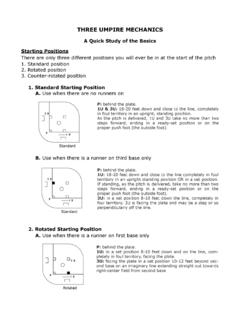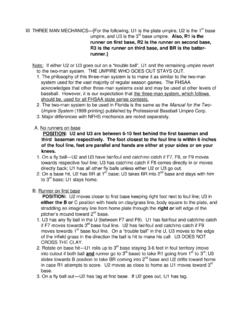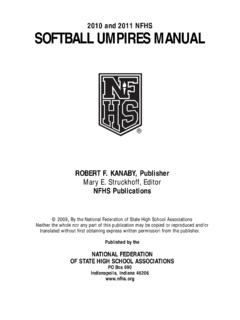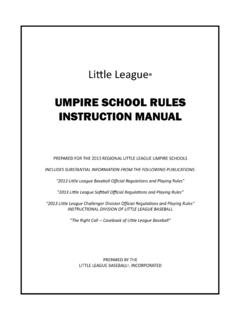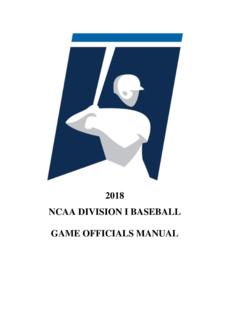Transcription of CANADIAN FOOTBALL LEAGUE OFFICIATING DEPARTMENT …
1 CANADIAN FOOTBALL LEAGUE . OFFICIATING DEPARTMENT . OFFICIALS' HANDBOOK. OFFICIALS' HANDBOOK. (As adapted for use by the CIS). The official who through the influence of his presence causes players to avoid rule violations has attained the perfect relationship to the game.. T. H. Shouldice, June 1969. CANADIAN FOOTBALL LEAGUE Pre-Snap Page 1. FIELD mechanics PLAYS FROM SCRIMMAGE. POSITIONAL RESPONSIBILITIES PRIOR TO THE SNAP. NOTE: Please see Diagram One at the end of this section for basic pre-snap crew alignment. REFEREE. Prior to each down, the Referee shall: 1. Check and agree with the Head Linesman regarding the down count. 2. Ensure the correct operation of the game and twenty second clocks.
2 3. Establish a position on the passing arm side of the quarterback. 4. Establish a position behind the line of scrimmage that provides a reasonable depth while at the same time ensures that you can observe the ball. 5. Ensure that the offensive team has five correctly numbered players in the interior block. Be alert and establish situations when the offensive team has players with eligible numbers in the interior block. Players occupying these positions must be duly registered with the game officials. 6. Split the line with the Umpire and observe the tactics and movement of the centre, the guard and offensive tackle on the side of the line of scrimmage where he (the Referee) is positioned.
3 (See diagrams following.) Be sure the offensive linemen under your observation have a proper pause and that, once set, do not move until the snap. 7. Count the number of players on the Offensive team. 8. The Quarterback is the responsibility of the Referee key on him. 9. Control Hurry-up or No Huddle offensive plays: a) Hold the field clock and/or the twenty-second clock. b) Check the position and readiness of the sticks, downs box and other officials. c) Confirm the alignment of Team A, the number of players, the numbering of the interior block. d) Signal the Umpire to assume his normal position. e) When, and only when, the Umpire is set signal Time In and allow the play to commence.
4 CFL OFFICIALS' HANDBOOK mechanics . CANADIAN FOOTBALL LEAGUE Pre-Snap Page 2. REFEREE Continued 10. On kicking plays the Referee is responsible for the kicker, his coverage, and any on- side players and knowing their respective jersey numbers. Diagram Referee and Umpire Pre-Snap Offensive Line Responsibilities (Referee on Quarterbacks Right Side). Umpire Referee Diagram Referee and Umpire Pre-Snap Offensive Line Responsibilities (Referee on Quarterbacks Left Side). Umpire Referee CFL OFFICIALS' HANDBOOK mechanics . CANADIAN FOOTBALL LEAGUE Pre-Snap Page 3. UMPIRE. Prior to each down, the Umpire shall: 1. Ensure that the down count is correct. 2. Count the number of players on the offensive team.
5 3. Assume a position that allows coverage of interior line play from tackle to tackle. 4. Establish a depth that prevents, as much as possible, interference with the players in your area of responsibility. 5. In conjunction with the Referee, control the Hurry-up or No Huddle offensive plays: a) The Umpire must be alert for the possibility that Team A will attempt to scrimmage the ball without a huddle. b) Should such a No Huddle situation arise, you must assume a position over the ball that prevents the Centre from snapping the ball. Straddle the ball with your feet and do not allow the Centre to get set. Be firm and be sure the play is not going to commence until the Referee has declared the ball ready for play.
6 C) Talk to the Centre and the Quarterback. Advise both players that they must wait for the Referee's whistle. Be calm and deliberate. d) When signaled by the Referee, assume your normal position as quickly as possible and be prepared for the up-coming play. 6. Split the line with the Referee and observe the tactics and movement of the centre, the guard and offensive tackle on the side of the line of scrimmage where he (the Umpire) is positioned. (See preceding diagrams at end of Referee section.). Be sure the offensive linemen under your observation have a proper pause and that, once set, do not move until the snap. 7. Ensure that the offensive team has five correctly numbered players in the interior block.
7 Be alert and establish situations when the offensive team has players with eligible numbers in the interior block. Players occupying these positions must be duly registered with the game officials. CFL OFFICIALS' HANDBOOK mechanics . CANADIAN FOOTBALL LEAGUE Pre-Snap Page 4. SIDELINE OFFICIALS. Prior to each down, the Head Linesman and Line Judge shall: 1. Establish a position that allows a full view of the line of scrimmage, team bench(s). and the substitution procedures of the team(s) on your side of the field. 2. Under the direction of the Referee control substitutions from your sideline. 3. Be alert for sleeper plays. 4. Ensure that the down count is correct. 5. Ensure that the offensive team has an eligible end on your side of the line of scrimmage.
8 6. Rule on the eligibility of slot backs and backs moving toward the line of scrimmage on your side of the field. 7. Establish a position that ensures that you will retain full outside control on all plays toward your sideline. Retain outside control never be forced to turn away from the play. 8. Establish a position that affords a view of the ball and provides the opportunity to rule on the tactics along the line of scrimmage. 9. Control the team bench(s) on your sideline. 10. As outlined in the General Positional Responsibilities section, the Sideline Officials shall determine the held sideman and he shall signal the rest of the crew by pointing to the line of scrimmage. 11.
9 In the event of a Hurry Up or No Huddle offensive play: a) Be aware of substitution proceedings and alert for a potential sleeper play. b) When the Referee signals the Umpire to clear the ball, immediately raise your arms to close the gates and terminate substitution. CFL OFFICIALS' HANDBOOK mechanics . CANADIAN FOOTBALL LEAGUE Pre-Snap Page 5. DOWNFIELD SIDELINE OFFICIALS. Prior to each down, the Side Judge and Back Judge shall: 1. Count the players of the defensive team. 2. Assist your sideline partner with the control of substitutions from your sideline. 3. Ensure the down count is correct. 4. Be alert for sleeper plays on your side of the field. From your down field position this coverage should be relatively easy.
10 5. Control the team bench(s) on your sideline. 6. Establish the offensive alignment on your side of the offensive set. 7. Be alert for Hurry-up offensive tactics. 8. Establish a position which best provides coverage of the active lines on your side. 9. Establish a position that ensures outside control on your sideline. CFL OFFICIALS' HANDBOOK mechanics . CANADIAN FOOTBALL LEAGUE Pre-Snap Page 6. FIELD JUDGE. Prior to each down, the Field Judge shall: 1. Be responsible for the twenty-second clocks. 2. Ensure that the down count is correct. 3. Count the players of the defensive team. 4. Observe the offensive formation and assume a position that favours the loaded side of the field.
